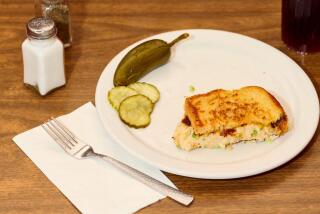Market Watch: The wild and elusive Dancy
While mandarin cultivation in California has quadrupled over the last decade to about 40,000 acres, the classic Dancy variety has fallen by the wayside, becoming rare to find even at farmers markets. That’s a shame, because it’s a charismatic, flavor-packed fruit, typical of what mandarins used to be like before they were hybridized with oranges and grapefruit for the sake of larger size and better handling.
The Dancy originated in Florida in 1867 from a seedling of the Moragne “tangierine,” which had been introduced a few decades earlier from Tangier, Morocco; the Moragne in turn derived from one of several similar types native to Asia. Widely planted in Florida from the late 19th century to about 20 years ago, Dancy was the prototypical “tangerine,” a term that has no botanical significance but refers popularly to mandarins with dark red-orange skin and a flattish shape.
The Dancy’s rind is thin, leathery and easily peeled, and it has an intense floral, fruity aroma. In fact, the skin is so thin, with very little albedo (the bitter white part) adhering to the flavedo (the glossy orange surface), that it is eminently edible fresh; and so the rind of Dancy or similar varieties traditionally has been used in Chinese dishes such as tangerine beef.
The Dancy’s flesh is tender but has a fair bit of chewy “rag” from the membranes surrounding the segments. Its acidity is high until fully ripe, and, as grown in the cooler areas of California, it can be a bit on the tart side for many palates. It’s sweetest grown in hot areas like the desert and the San Joaquin Valley, where it was used to pollenize the Minneola tangelo, its daughter variety.
Dancy makes incomparably rich juice, and even a little goes a long way to pep up bland orange juice.
Why has Dancy virtually disappeared from markets? It’s quite seedy, at a time when the public increasingly expects seedlessness in fresh mandarins. The thin rind tears easily and allows moisture to transpire, so Dancy doesn’t ship or store well. In addition, the fruit size tends to be small in California. In Florida, Dancy has been supplanted by Fallglo and Sunburst, and in California by clementines and W. Murcott Afourer mandarins.
Tony Thacher of Friend’s Ranches in Ojai once grew 5 acres of Dancy, many of them ancient trees from the 1920s with foot-thick trunks, but cut most of them down several years ago to make way for newer varieties. He still has 100 trees and sells the fruits at the Hollywood, Ojai and Santa Monica Wednesday markets. Prime season is February and March, sometimes extending into April. They’re particularly popular at Chinese New Year, which will be Feb. 3 this year.
“You can’t beat the flavor of a good Dancy,” Thacher said. “That’s still the best.”
For Dancys from the San Joaquin Valley, which are still occasionally available at stores, the season is January to March. Most Southern California fruits start a month or more later. In a few weeks, Thys Ranch of Fallbrook will have Dancys at both Torrance farmers markets, and Dave Eakin of Riverside will start selling them to Beverly Hills Juice, which juices the fruit at the Santa Monica Sunday market. Mike and Mary Shore of Timber Canyon Ranch will offer them in about a month at the Ventura (Wednesday and Saturday), Thousand Oaks and Santa Clarita markets.
The Dancy’s intensity is not to everybody’s taste — one friend who is very knowledgeable about citrus said she was put off by its “wild” aroma. Personally I love it, and that’s what I crave in my tangerine dreams. Sherry Yard, executive pastry chef of Spago, agrees; on Wednesday she quipped as she sampled a Dancy, “Nothing is too wild for me!”
More to Read
Eat your way across L.A.
Get our weekly Tasting Notes newsletter for reviews, news and more.
You may occasionally receive promotional content from the Los Angeles Times.






